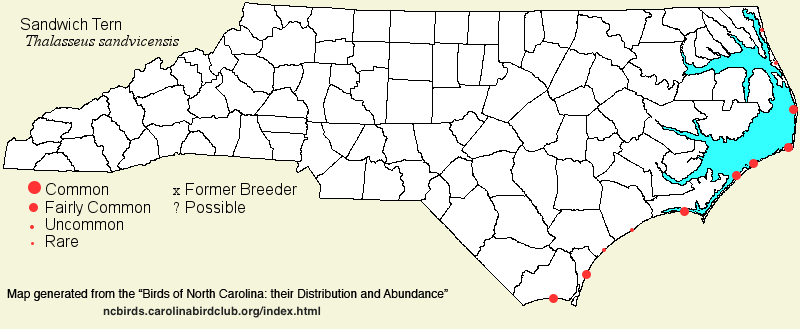 |  |
|
Sandwich Tern - Thalasseus sandvicensis LARIDAE Members: | Search Common: Search Scientific: |
|
|
|||||||
| General Comments |
The Sandwich Tern is the Royal Tern's "little brother"; it always nests in flocks of Royal Terns, resting on sand bars and flats with that species, and feeding with it over the ocean and around inlets. As with the Royal, this species is strictly coastal, never seen far inland except after storms. Also as with the Royal, there are no records of the Sandwich Tern for the mountain region. However, Sandwich Terns clear out of the state by late fall and do not overwinter along our coast, though there are a number of early-winter records of stragglers. Sandwich Terns also avoid fresh water, preferring to feed over the inshore ocean, and even relatively few birds feed in the sounds and around inlets.
The Cayenne race (T. s. eurygnatha), which breeds in northern South America, is a casual coastal visitor, with 7 published records, between 5 Apr and 23 Sep. The last was quite late, at Cape Hatteras Point on 6 Nov 2023. Most records are from this locale. | ||||||
| Breeding Status | Breeder | ||||||
| NC BRC List | Definitive | ||||||
| State Status | |||||||
| U.S. Status | |||||||
| State Rank | S3S4B | ||||||
| Global Rank | G5 | ||||||
| Coastal Plain | Summer resident (breeding) and migrant along the coast. Fairly common along the coast in summer and migration, and locally common around nesting colonies. Small numbers linger well into Nov, and there are a scattering of CBC records in late Dec; however, there are only two Jan records and no Feb records. Mostly occurs along the coast late Mar to late Nov. Nests only on small coastal islands, and never on barrier islands. In the Tidewater zone, it is very rare in the warmer months. Farther inland, it is casual to very rare in summer and fall, after storms; 11 records between mid-Jul and mid-Sep. Peak counts: 2,000, Cape Hatteras Point (Dare), 18 Oct 2018; 300, Barden's Inlet (Carteret),12 Nov 2003. | ||||||
| Piedmont | Storm-related visitor, in early fall, to large lakes and reservoirs, but only close to the Fall Line (eastern edge of the province). Very rare, with 14 records; all records between late Aug and mid-Sep. Five of these records came in mid-Sep 2018 following the passage of Hurricane Florence. Peak counts: 15, Jordan Lake, 6-7 Sep 1996 (after Hurricane Fran); 10, Roanoke Rapids Lake, 19 Sep 2003 (after Hurricane Isabel). | ||||||
| Mountains | No records. | ||||||
| Finding Tips |
This tern is usually seen in a day of birding at Oregon Inlet or near the Pea Island impoundments. The large tidal pond at Cape Hatteras Point is good after the birds have finished nesting, such as Aug into Oct. They are not hard to find around Beaufort Inlet or in the Fort Fisher/lower Cape Fear River area. *** | ||||||
| Attribution | LeGrand[2024-02-10], LeGrand[2023-03-14], LeGrand[2020-02-08] | ||||||
| NC Map Map depicts all counties with a report (transient or resident) for the species. | Click on county for list of all known species. |
| NC Breeding Season Map Map depicts assumed breeding season abundance for the species. |  |